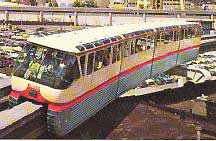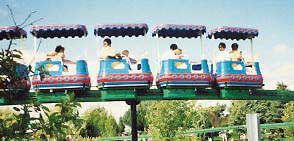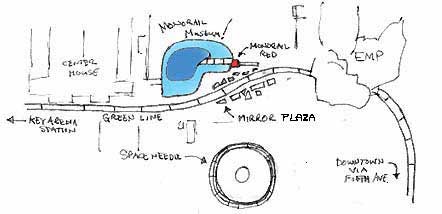A Monorail Museum - A Proposal
by Kim Pedersen (May 30, 2002)
This editorial was written well before the demise of the Seattle Monorail Project in 2005. The concept for a Monorail Museum is still valid, so we are keeping it online to continue the discussion going on the concept.
As I write this editorial, it appears that the Seattle Monorail
Project is moving towards having an initial alignment that would
partially follow along the same route as the current Seattle Center
Monorail (Fifth Avenue). This would likely require the removal
of the historical Alweg Monorail, which first opened for the 1962
Seattle Century 21 World's Fair. While this editorial could be
perceived as being a bit premature, I'd still like to throw out
an idea that I've been kicking around in my head for sometime.
It certainly doesn't hurt to get the wheels rolling early!
 What is to become
of the current monorail trains if a new system is built? I personally
would like to see a Monorail Museum built in which at least Monorail
Red's "Elvis" train is preserved for future generations.
Perhaps the museum location could be at the Seattle Center, where
the current station is. I don't think that it would take an enormous
amount of land, yet the love Seattle citizens have shown for their
monorail leads me to believe that it would be a natural for the
Center. At this point it's uncertain whether the proposed Green
Line will cut through the Center or circle around it. If I had
my way, it would run through the Center from Thomas Street, then
wind it's way through the Experience Museum Project (see map sketch
below). That building was specifically designed with a tunnel
for the monorail, it should remain that way. But I digress, this
editorial is about a museum after all! What is to become
of the current monorail trains if a new system is built? I personally
would like to see a Monorail Museum built in which at least Monorail
Red's "Elvis" train is preserved for future generations.
Perhaps the museum location could be at the Seattle Center, where
the current station is. I don't think that it would take an enormous
amount of land, yet the love Seattle citizens have shown for their
monorail leads me to believe that it would be a natural for the
Center. At this point it's uncertain whether the proposed Green
Line will cut through the Center or circle around it. If I had
my way, it would run through the Center from Thomas Street, then
wind it's way through the Experience Museum Project (see map sketch
below). That building was specifically designed with a tunnel
for the monorail, it should remain that way. But I digress, this
editorial is about a museum after all!
I've come up with the following ideas for the museum. I'm sure
that others will have ideas to add, or ideas to modify my proposals.
It's early in the process, the sky is the limit. My fantasy Seattle
Monorail Museum features:
- Suggested architecture. I think 1960s "futurist-fantasy"
architecture would be ideal. A building that looks like art renderings
and models some of us saw at World's Fairs of that time. This
design would blend well with the "Jetson's" architecture
of the nearby Space Needle.
- Seattle's Monorail Red. Climb aboard and see Elvis
sitting where he rode in the film "It Happened at the World's
Fair." Monorail Red sits on top of beamway that was once
in the Seattle Center station, it won't need to be moved! See
film clips from various movies and TV shows, all which have featured
the Seattle Monorail, with stars and celebrity riders like Sylvester
Stallone, John Lithgow, Kelsey Grammer (Frasier), John Glenn
and of course, Elvis. Then take a walk under the train to get
a sneak peak at what makes the monorail run along the guideway.
A couple of the side skirts have cutaways that reveal the motor,
guide wheels and a load wheel.
- Monorail History. A fascinating display of video monitors,
models and artifacts depict the history of monorails dating back
to the 1800s. With a little luck and determination, perhaps other
monorail cars could be obtained for this section, such as a car
from the New York World's Fair AMF monorail. If the Disney Company
was willing, a retired Mark IV cab from Walt Disney World would
be a terrific display. The company was willing to auction a monorail
cab, perhaps they wouldn't mind a museum tribute to Walt's belief
in future transport. Heck, as long as I'm dreaming, maybe we
could get Walt Disney Imagineering to design the entire museum.
It wouldn't be cheap, but the result could be spectacular.
- How do they work? Large easy-to-understand mobile
displays that show just how both suspended and straddle beam
monorails work. Included are some hands-on displays for the kids.
- Monorails of the World. Again, video monitors, models
and artifacts depicting current monorails in operation around
the world. In my experience, most people (including diehard rail
fans) are surprised and shocked when they find out how many transit
monorails are in operation or being built around the world. Children
and adults alike can sit down in miniature monorail cabs to "ride"
monorails from selecting them on the control panel and watching
high definition on board video footage. Perhaps a speed control
can be included so station stops can be practiced. This section
will help dispel the "monorails are for amusement parks
only" mindset that we've been battling for decades.
- Monorail Theatre. Run on a regular basis are historical
films and of course, a film depicting the history of Seattle's
Monorail, starting from the early 1900's proposals to the citywide
monorail system, built as a result of an incredible grassroots
campaign (we hope!).
- Monorail fandom. A collector's paradise. See hundreds
of postcards, monorail toys, models, and souvenirs from Wuppertal,
Germany to Tokyo Disneyland, all related to monorails. A spectacular
model railroad with various types of monorails winding along
city streets, over rivers, through tunnels and through buildings.
Drop a few coins into nearby control boxes and you can operate
their speed and make them stop at various stations.
 Children's minirail. A small ridable monorail weaves its way through the building
and perhaps outside and around. It will provide entertainment
for families as well as add more visual motion to a museum about
moving people. It should draw more people into the museum when
seen from the outside. Children's minirail. A small ridable monorail weaves its way through the building
and perhaps outside and around. It will provide entertainment
for families as well as add more visual motion to a museum about
moving people. It should draw more people into the museum when
seen from the outside.
- Souvenir shop. What's a museum without a shop?
- Mirror Plaza. An open courtyard where the new Seattle
Monorail runs through the Seattle Center on its way to the EMP
Museum existing tunnel. A large multi-piece sculpture surrounds
the guide way with hundreds of mirror-reflective surfaces and
prisms. The fanciful mirrors come alive as they reflect passing
monorails, the nearby Space Needle, courtyard visitors and the
ever-changing skyscape above. The prisms change as the light
of the day changes. This could be the icon of the entrance of
the museum and provide more eye candy for the center. And let's
not forget the monorail riders passing through the center of
this, they will also be treated to unique reflections of the
train they're riding on as well as the surrounding environment.

A Monorail Museum has been one of the goals I have dreamt of
for a long time, going back to the days of the founding of the
Monorail Society in 1989. I think the City of Seattle (if
the new monorail gets a yes vote in November of this year), would
be an ideal location for it. I would be happy to donate a large
amount of artifacts, photographs, toys, video, and collectibles
that I have accumulated over the years for display at the museum.
I'm confident others would do the same.
Just from my own experience at various monorails around the
world, I have witnessed firsthand that the general public has
a great fascination for monorails. They are always the focus of
positive attention, no matter which one I visit. For this reason,
I believe a well-designed Monorail Museum would be popular and
it would add one more terrific incentive for people to visit Seattle
Center. What do you think Seattleites?
 / back to the Editorials Page] / back to the Editorials Page]
|
 What is to become
of the current monorail trains if a new system is built? I personally
would like to see a Monorail Museum built in which at least Monorail
Red's "Elvis" train is preserved for future generations.
Perhaps the museum location could be at the Seattle Center, where
the current station is. I don't think that it would take an enormous
amount of land, yet the love Seattle citizens have shown for their
monorail leads me to believe that it would be a natural for the
Center. At this point it's uncertain whether the proposed Green
Line will cut through the Center or circle around it. If I had
my way, it would run through the Center from Thomas Street, then
wind it's way through the Experience Museum Project (see map sketch
below). That building was specifically designed with a tunnel
for the monorail, it should remain that way. But I digress, this
editorial is about a museum after all!
What is to become
of the current monorail trains if a new system is built? I personally
would like to see a Monorail Museum built in which at least Monorail
Red's "Elvis" train is preserved for future generations.
Perhaps the museum location could be at the Seattle Center, where
the current station is. I don't think that it would take an enormous
amount of land, yet the love Seattle citizens have shown for their
monorail leads me to believe that it would be a natural for the
Center. At this point it's uncertain whether the proposed Green
Line will cut through the Center or circle around it. If I had
my way, it would run through the Center from Thomas Street, then
wind it's way through the Experience Museum Project (see map sketch
below). That building was specifically designed with a tunnel
for the monorail, it should remain that way. But I digress, this
editorial is about a museum after all! Children's minirail. A small ridable monorail weaves its way through the building
and perhaps outside and around. It will provide entertainment
for families as well as add more visual motion to a museum about
moving people. It should draw more people into the museum when
seen from the outside.
Children's minirail. A small ridable monorail weaves its way through the building
and perhaps outside and around. It will provide entertainment
for families as well as add more visual motion to a museum about
moving people. It should draw more people into the museum when
seen from the outside.
